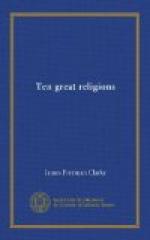That the belief in transmigration is the explanation of animal worship is the opinion of Bunsen. The human soul and animal soul, according to this view, are essentially the same,—therefore the animal was considered as sacred as man. Still, we do not worship man. Animal worship, then, must have had a still deeper root in the sense of awe before the mystery of organized life.
Sec. 5. Sources of Egyptian Theology. Age of the Empire and Affinities of the Race.
But whence came this tendency in the human mind? Did it inhere in the race, or was it the growth of external circumstances? Something, perhaps, may be granted to each of these causes. The narrow belt of fertile land in Egypt, fed by the overflowing Nile, quickened by the tropical sun, teeming with inexhaustible powers of life, continually called the mind anew to the active, creative powers of nature. And yet it may be suspected that the law of movement by means of antagonism and reaction may have had its influence also here. The opinion is now almost universal, that the impulse of Egyptian civilization proceeded from Asia. This is the conclusion of Bunsen at the end of his first volume. “The cradle of the mythology and language of Egypt,” says he, “is Asia. This result is arrived at by the various ethnological proofs of language which finds Sanskrit words and forms in Egypt, and of comparative anatomy, which shows the oldest Egyptian skulls to have belonged to Caucasian races.” If, then, Egyptian civilization proceeded from Central Asia, Egyptian mythology and religion probably came as a quite natural reaction from the extreme spiritualism of the Hindoos. The question which remains is, whether they arrived at their nature-worship directly or indirectly; whether, beginning with Fetichism, they ascended to their higher conceptions of the immortal gods; or, beginning with spiritual existence, they traced it downward into its material manifestations; whether, in short, their system was one of evolution or emanation. For every ancient theogony, cosmogony, or ontogony is of one kind or the other. According to the systems of India and of Platonism, the generation of beings is by the method of emanation. Creation is a falling away, or an emanation from the absolute. But the systems of Greek and Scandinavian mythology are of the opposite sort. In these, spirit is evolved from matter; matter up to spirit works. They begin with the lowest form of being,—night, chaos, a mundane egg,—and evolve the higher gods therefrom.




